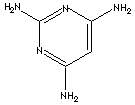| CAS
NO. |
1004-38-2
|

|
| EINECS
NO. |
213-720-7 |
| FORMULA |
C4H7N5 |
| MOL
WT. |
125.14 |
| H.S.
CODE |
|
| TOXICITY |
Oral
rat LD50: 2156 mg/kg
|
| SYNONYMS |
2,4,6-Pyrimidinetriamine;
|
|
2,4,6-Triaminopyrimidin
(German); 2,4,6-Triaminopyrimidine (French); 2,4,6-Triaminopirimidina
(Italian);
|
| RAW
MATERIALS |
|
|
CLASSIFICATION
|
|
|
PHYSICAL
AND CHEMICAL PROPERTIES
|
| PHYSICAL
STATE |
off white powder
|
| MELTING
POINT |
249
- 253 C
|
| BOILING
POINT |
|
| SPECIFIC
GRAVITY |
|
| SOLUBILITY
IN WATER |
|
| pH |
|
| VAPOR
DENSITY |
|
| AUTOIGNITION
|
|
| NFPA
RATINGS |
Health:
1; Flammability: 0; Reactivity: 0 |
|
REFRACTIVE
INDEX
|
|
| FLASH
POINT |
|
| STABILITY |
Stable
under ordinary conditions. |
|
APPLICATIONS
|
| Pyrimidine
is any heterocyclic organic compounds characterized
by a ring structure composed of four carbon atoms and
two nitrogen atoms at 1 and 3 positions. There are naturally
occurring derivatives which are are components of nucleotides
and nucleic acids such as cytosine, thymine, and uracil.
Pyrimidine can be used as a chemical intermediate to
prepare biologically important derivatives. 2,4,6-Triaminopryrimidine
is used as an intermediate for agrochemicals. It is
a building block for various chemical synthesis. |
| SALES
SPECIFICATION |
|
APPEARANCE
|
off white powder
|
| ASSAY
(TIT) |
99.0
- 100.3%
|
| TRANSPORTATION |
| PACKING |
|
| HAZARD
CLASS |
|
| UN
NO. |
|
| OTHER
INFORMATION |
| Hazard Symbols: XI, Risk Phrases: 36/37/38, Safety Phrases:
26/37/39 |
